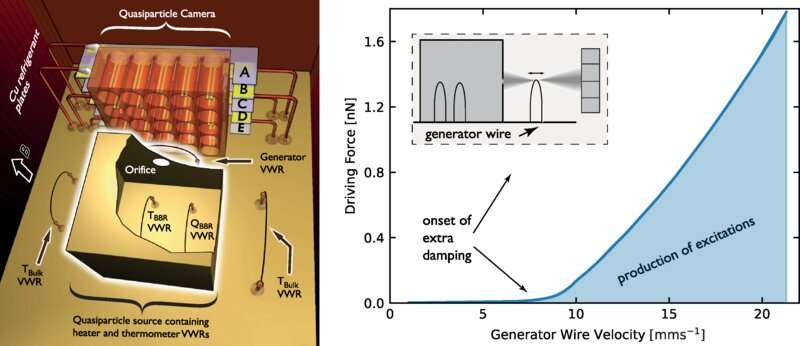(Left) A sketch of the experimental cell used to controllably destroy the superfluidity and image an accompanying quantum vortex tangle. The quasiparticle source (blackbody radiator, BBR) illuminates a turbulent tangle created by the generator wire in front of a quasiparticle camera. The BBR consists of a box, containing two vibrating wires to generate (heater QBBR) and detect (thermometer TBBR) excitations. Excitations produced within the box quickly thermalize and emerge from a small hole (the radiator orifice), forming a wide beam of ballistic excitations. The beam propagates towards the quasiparticle camera , which is placed 2 mm away from the radiator's orifice and has a 5×5 array of pixels. Each pixel in the camera consists of a 1-mm-diameter cylindrical cavity in a copper matrix with a miniature quartz tuning fork resonator inside that detects incident quasiparticles. The turbulent tangle reduces number the quasiparticles reaching the camera and forms a shadowgram. (Right) The force-velocity dependence of the generator wire. The onset velocity for excitation production is highlighted by an arrow. The inset depicts emission of a quasiparticle beam by the generator wire above the onset velocity. Credit: Physical Review B (2022). DOI: 10.1103/PhysRevB.105.174515
Lancaster researchers have developed a camera-like device able to image mini whirlpools in quantum liquids for the first time ever.
Vortices form in stirred fluids, when water drains into a plughole and can also be seen in tornadoes and cyclones.
These vortices are unpredictable, unlike in quantum liquids where the vortices always have the same size due to quantum effects that only arise at very cold temperatures such as with the superfluid liquid helium-3.
The problem is that quantum vortices by their very nature are too small to be captured without tracer particles by a conventional camera—until now.
Physicists at Lancaster University led by Dr. Theo Noble have developed a new type of camera which uses particle-like disturbances to take images of collections of vortices instead of light.
Their work is published in the journal Physical Review B.
The camera is a five-by-five array of pixels. Each of the 25 pixels is a millimeter-sized cylindrical cavity with a quartz tuning fork in the middle.
The team tested the camera on vortices created by a vibrating wire in a form of ultra cold helium.
Dr. Theo Noble explains: "The experiment works like shining a torch on a shadow puppet. We then measure the shadows cast by quantum vortices across the camera."
Even with its low number of pixels, the new camera uncovered that most vortices form above the vibrating wire instead of developing all around it.
The Head of the Ultra Low Temperature Laboratory at Lancaster University Dr. Viktor Tsepelin said that this was not predicted by mathematical theories or numerical simulations.
Dr. Tsepelin's goal now is to build a 90-pixel camera with a high enough resolution to image the details of development and decay of carefully prepared collections of vortices. This ability to observe the dynamics of superfluid helium-3 will improve the understanding of the turbulent motion of quantum fluids and turbulence in general.
Dr. Viktor Tsepelin said "It is exciting to see that our prototype is working. The high-resolution camera could also be used to image other topological defects existing in superfluid helium-3 allowing us to have a glimpse at an analog of the early universe."
More information: M. T. Noble et al, Producing and imaging quantum turbulence via pair-breaking in superfluid He3−B, Physical Review B (2022). DOI: 10.1103/PhysRevB.105.174515
Journal information: Physical Review B
Provided by Lancaster University
























